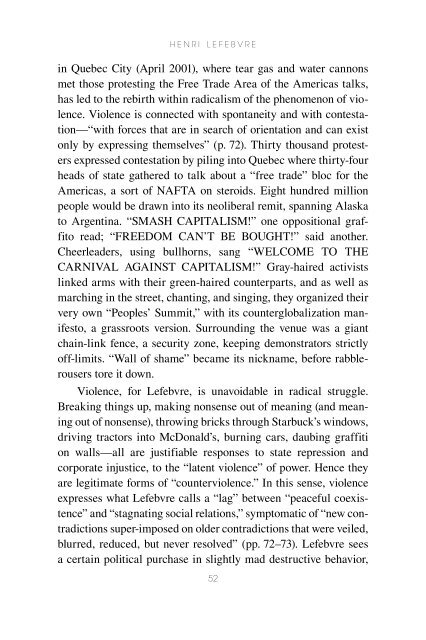Henri Lefebvre: A Critical Introduction - autonomous learning
Henri Lefebvre: A Critical Introduction - autonomous learning
Henri Lefebvre: A Critical Introduction - autonomous learning
Create successful ePaper yourself
Turn your PDF publications into a flip-book with our unique Google optimized e-Paper software.
H e n r i L e F e b v r e<br />
in Quebec City (April 2001), where tear gas and water cannons<br />
met those protesting the Free Trade Area of the Americas talks,<br />
has led to the rebirth within radicalism of the phenomenon of violence.<br />
Violence is connected with spontaneity and with contestation—“with<br />
forces that are in search of orientation and can exist<br />
only by expressing themselves” (p. 72). Thirty thousand protesters<br />
expressed contestation by piling into Quebec where thirty-four<br />
heads of state gathered to talk about a “free trade” bloc for the<br />
Americas, a sort of NAFTA on steroids. Eight hundred million<br />
people would be drawn into its neoliberal remit, spanning Alaska<br />
to Argentina. “SMASH CAPITALISM!” one oppositional graffito<br />
read; “FREEDOM CAN’T BE BOUGHT!” said another.<br />
Cheerleaders, using bullhorns, sang “WELCOME TO THE<br />
CARNIVAL AGAINST CAPITALISM!” Gray-haired activists<br />
linked arms with their green-haired counterparts, and as well as<br />
marching in the street, chanting, and singing, they organized their<br />
very own “Peoples’ Summit,” with its counterglobalization manifesto,<br />
a grassroots version. Surrounding the venue was a giant<br />
chain-link fence, a security zone, keeping demonstrators strictly<br />
off-limits. “Wall of shame” became its nickname, before rabblerousers<br />
tore it down.<br />
Violence, for <strong>Lefebvre</strong>, is unavoidable in radical struggle.<br />
Breaking things up, making nonsense out of meaning (and meaning<br />
out of nonsense), throwing bricks through Starbuck’s windows,<br />
driving tractors into McDonald’s, burning cars, daubing graffiti<br />
on walls—all are justifiable responses to state repression and<br />
corporate injustice, to the “latent violence” of power. Hence they<br />
are legitimate forms of “counterviolence.” In this sense, violence<br />
expresses what <strong>Lefebvre</strong> calls a “lag” between “peaceful coexistence”<br />
and “stagnating social relations,” symptomatic of “new contradictions<br />
super-imposed on older contradictions that were veiled,<br />
blurred, reduced, but never resolved” (pp. 72–73). <strong>Lefebvre</strong> sees<br />
a certain political purchase in slightly mad destructive behavior,<br />
52
















